Business Structures: Partnership, Trust, and Company Analysis
VerifiedAdded on 2023/05/29
|14
|3742
|481
Report
AI Summary
This report provides a comprehensive analysis of three primary business structures: partnerships, trusts, and companies. It begins by defining each structure, outlining their key characteristics, and evaluating their respective advantages and disadvantages, with a focus on legal and operational aspects. The report then delves into the specific rights, duties, and liabilities associated with each structure, examining the roles and responsibilities of partners, trustees, and company directors and shareholders. It references relevant legislation, including the Partnership Act 1891 (Qld) and the Corporations Act 2001 (Cth), to illustrate the legal frameworks governing these structures. The analysis covers aspects such as formation, management, liability, and the distribution of profits and benefits, providing a comparative perspective to aid in the selection of an appropriate business structure. The report also touches upon the importance of fiduciary duties and the potential implications of non-compliance with legal obligations.

0
Companies and Business Structure
Companies and Business Structure
Paraphrase This Document
Need a fresh take? Get an instant paraphrase of this document with our AI Paraphraser
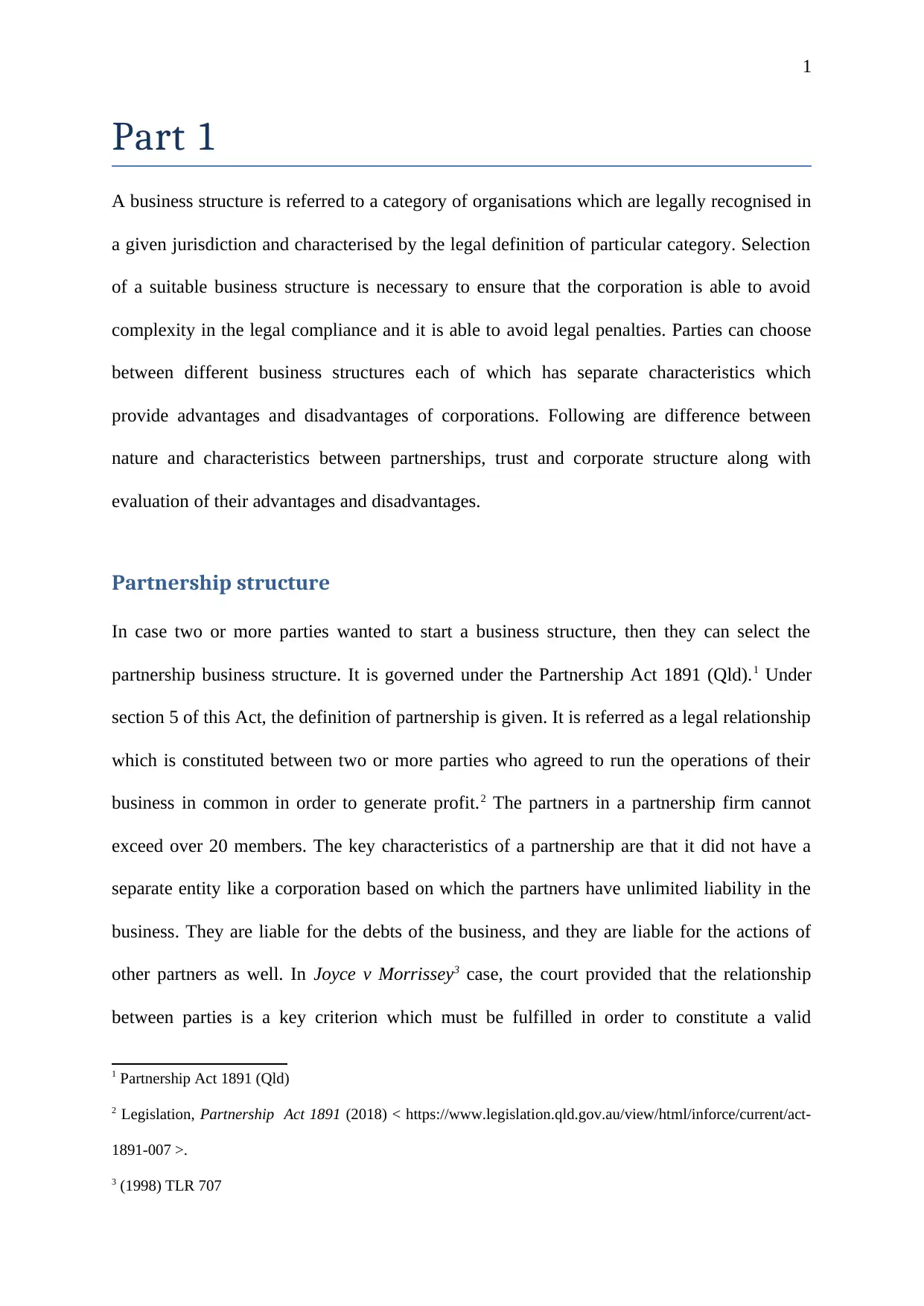
1
Part 1
A business structure is referred to a category of organisations which are legally recognised in
a given jurisdiction and characterised by the legal definition of particular category. Selection
of a suitable business structure is necessary to ensure that the corporation is able to avoid
complexity in the legal compliance and it is able to avoid legal penalties. Parties can choose
between different business structures each of which has separate characteristics which
provide advantages and disadvantages of corporations. Following are difference between
nature and characteristics between partnerships, trust and corporate structure along with
evaluation of their advantages and disadvantages.
Partnership structure
In case two or more parties wanted to start a business structure, then they can select the
partnership business structure. It is governed under the Partnership Act 1891 (Qld).1 Under
section 5 of this Act, the definition of partnership is given. It is referred as a legal relationship
which is constituted between two or more parties who agreed to run the operations of their
business in common in order to generate profit.2 The partners in a partnership firm cannot
exceed over 20 members. The key characteristics of a partnership are that it did not have a
separate entity like a corporation based on which the partners have unlimited liability in the
business. They are liable for the debts of the business, and they are liable for the actions of
other partners as well. In Joyce v Morrissey3 case, the court provided that the relationship
between parties is a key criterion which must be fulfilled in order to constitute a valid
1 Partnership Act 1891 (Qld)
2 Legislation, Partnership Act 1891 (2018) < https://www.legislation.qld.gov.au/view/html/inforce/current/act-
1891-007 >.
3 (1998) TLR 707
Part 1
A business structure is referred to a category of organisations which are legally recognised in
a given jurisdiction and characterised by the legal definition of particular category. Selection
of a suitable business structure is necessary to ensure that the corporation is able to avoid
complexity in the legal compliance and it is able to avoid legal penalties. Parties can choose
between different business structures each of which has separate characteristics which
provide advantages and disadvantages of corporations. Following are difference between
nature and characteristics between partnerships, trust and corporate structure along with
evaluation of their advantages and disadvantages.
Partnership structure
In case two or more parties wanted to start a business structure, then they can select the
partnership business structure. It is governed under the Partnership Act 1891 (Qld).1 Under
section 5 of this Act, the definition of partnership is given. It is referred as a legal relationship
which is constituted between two or more parties who agreed to run the operations of their
business in common in order to generate profit.2 The partners in a partnership firm cannot
exceed over 20 members. The key characteristics of a partnership are that it did not have a
separate entity like a corporation based on which the partners have unlimited liability in the
business. They are liable for the debts of the business, and they are liable for the actions of
other partners as well. In Joyce v Morrissey3 case, the court provided that the relationship
between parties is a key criterion which must be fulfilled in order to constitute a valid
1 Partnership Act 1891 (Qld)
2 Legislation, Partnership Act 1891 (2018) < https://www.legislation.qld.gov.au/view/html/inforce/current/act-
1891-007 >.
3 (1998) TLR 707
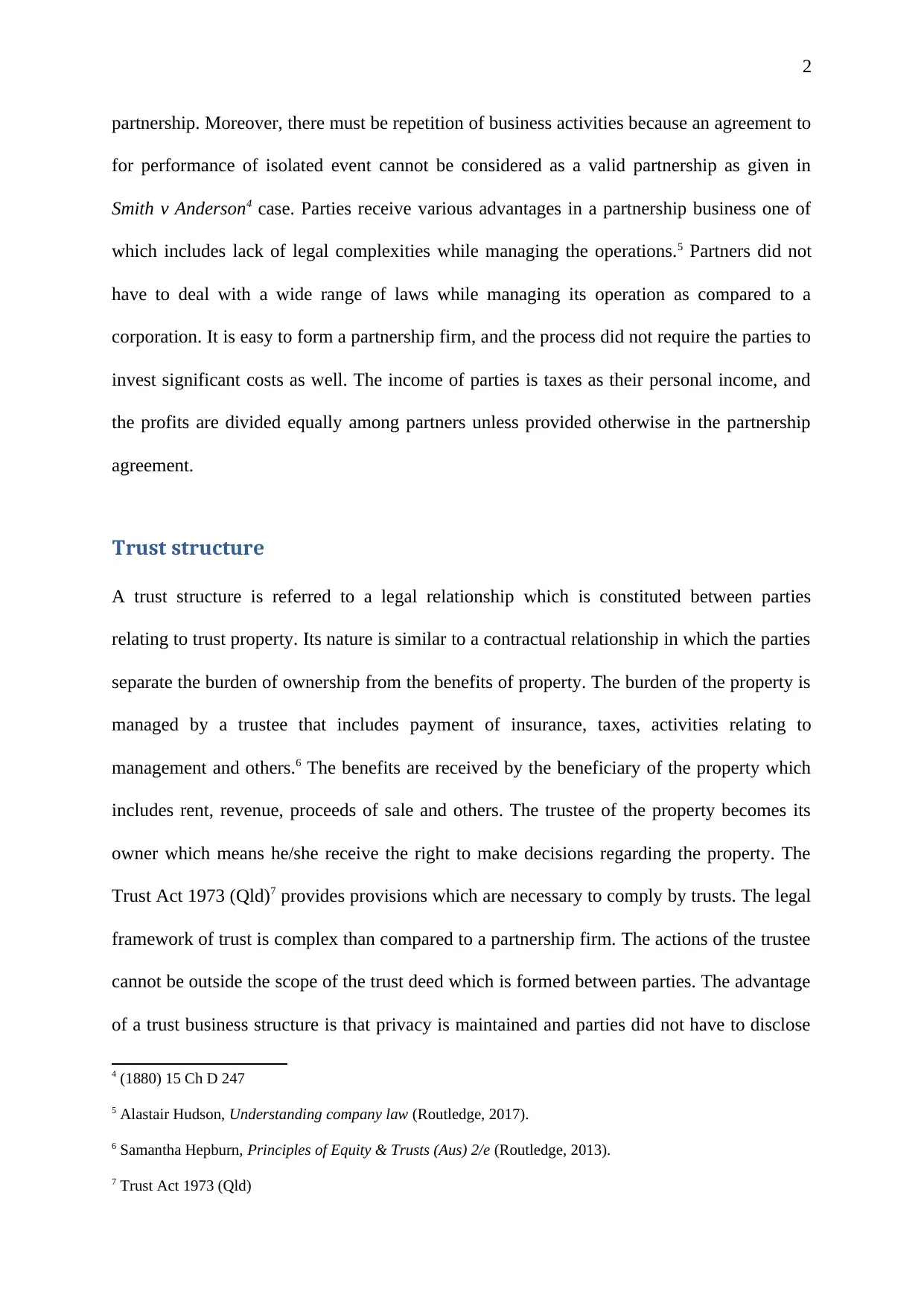
2
partnership. Moreover, there must be repetition of business activities because an agreement to
for performance of isolated event cannot be considered as a valid partnership as given in
Smith v Anderson4 case. Parties receive various advantages in a partnership business one of
which includes lack of legal complexities while managing the operations.5 Partners did not
have to deal with a wide range of laws while managing its operation as compared to a
corporation. It is easy to form a partnership firm, and the process did not require the parties to
invest significant costs as well. The income of parties is taxes as their personal income, and
the profits are divided equally among partners unless provided otherwise in the partnership
agreement.
Trust structure
A trust structure is referred to a legal relationship which is constituted between parties
relating to trust property. Its nature is similar to a contractual relationship in which the parties
separate the burden of ownership from the benefits of property. The burden of the property is
managed by a trustee that includes payment of insurance, taxes, activities relating to
management and others.6 The benefits are received by the beneficiary of the property which
includes rent, revenue, proceeds of sale and others. The trustee of the property becomes its
owner which means he/she receive the right to make decisions regarding the property. The
Trust Act 1973 (Qld)7 provides provisions which are necessary to comply by trusts. The legal
framework of trust is complex than compared to a partnership firm. The actions of the trustee
cannot be outside the scope of the trust deed which is formed between parties. The advantage
of a trust business structure is that privacy is maintained and parties did not have to disclose
4 (1880) 15 Ch D 247
5 Alastair Hudson, Understanding company law (Routledge, 2017).
6 Samantha Hepburn, Principles of Equity & Trusts (Aus) 2/e (Routledge, 2013).
7 Trust Act 1973 (Qld)
partnership. Moreover, there must be repetition of business activities because an agreement to
for performance of isolated event cannot be considered as a valid partnership as given in
Smith v Anderson4 case. Parties receive various advantages in a partnership business one of
which includes lack of legal complexities while managing the operations.5 Partners did not
have to deal with a wide range of laws while managing its operation as compared to a
corporation. It is easy to form a partnership firm, and the process did not require the parties to
invest significant costs as well. The income of parties is taxes as their personal income, and
the profits are divided equally among partners unless provided otherwise in the partnership
agreement.
Trust structure
A trust structure is referred to a legal relationship which is constituted between parties
relating to trust property. Its nature is similar to a contractual relationship in which the parties
separate the burden of ownership from the benefits of property. The burden of the property is
managed by a trustee that includes payment of insurance, taxes, activities relating to
management and others.6 The benefits are received by the beneficiary of the property which
includes rent, revenue, proceeds of sale and others. The trustee of the property becomes its
owner which means he/she receive the right to make decisions regarding the property. The
Trust Act 1973 (Qld)7 provides provisions which are necessary to comply by trusts. The legal
framework of trust is complex than compared to a partnership firm. The actions of the trustee
cannot be outside the scope of the trust deed which is formed between parties. The advantage
of a trust business structure is that privacy is maintained and parties did not have to disclose
4 (1880) 15 Ch D 247
5 Alastair Hudson, Understanding company law (Routledge, 2017).
6 Samantha Hepburn, Principles of Equity & Trusts (Aus) 2/e (Routledge, 2013).
7 Trust Act 1973 (Qld)
⊘ This is a preview!⊘
Do you want full access?
Subscribe today to unlock all pages.

Trusted by 1+ million students worldwide
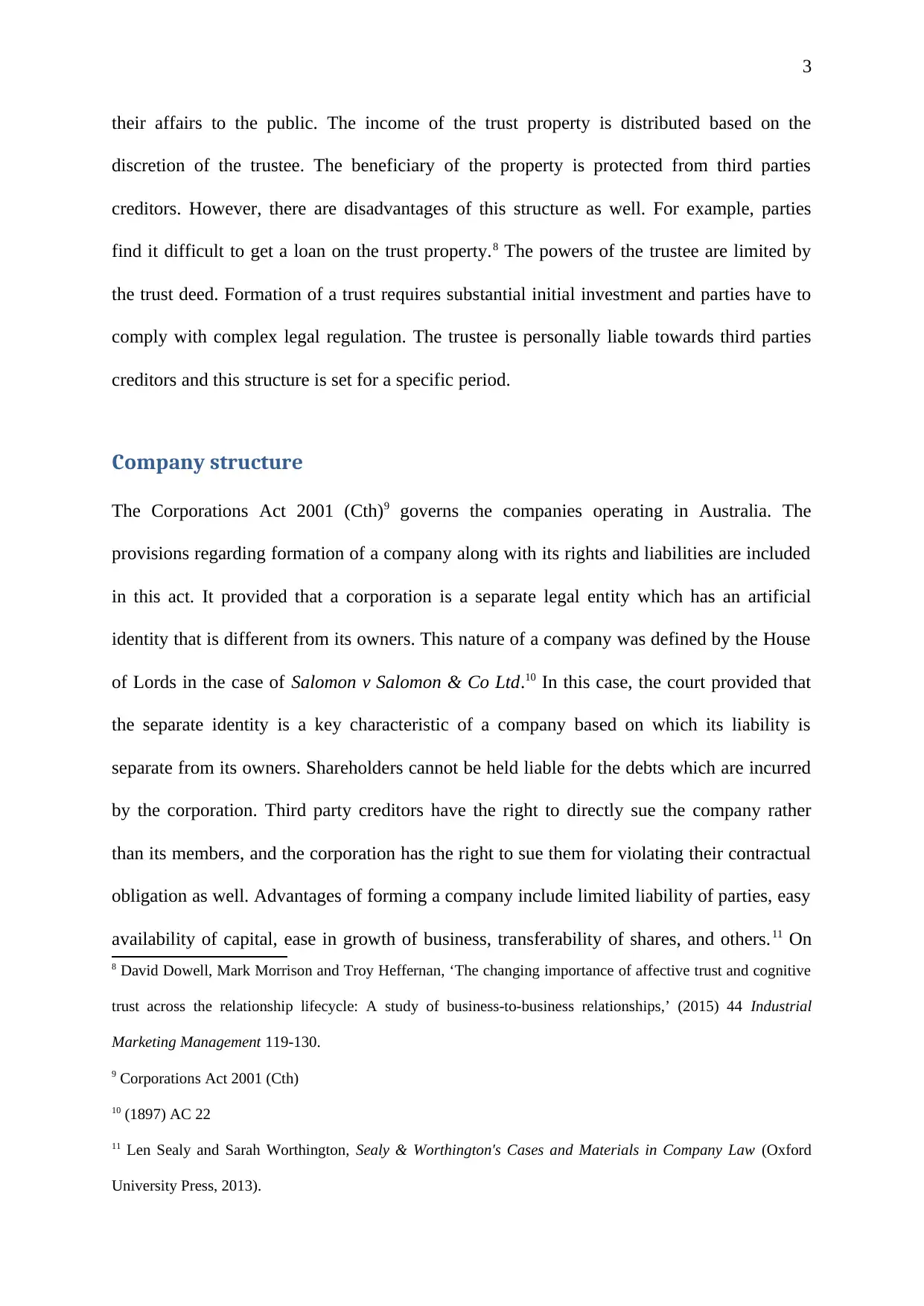
3
their affairs to the public. The income of the trust property is distributed based on the
discretion of the trustee. The beneficiary of the property is protected from third parties
creditors. However, there are disadvantages of this structure as well. For example, parties
find it difficult to get a loan on the trust property.8 The powers of the trustee are limited by
the trust deed. Formation of a trust requires substantial initial investment and parties have to
comply with complex legal regulation. The trustee is personally liable towards third parties
creditors and this structure is set for a specific period.
Company structure
The Corporations Act 2001 (Cth)9 governs the companies operating in Australia. The
provisions regarding formation of a company along with its rights and liabilities are included
in this act. It provided that a corporation is a separate legal entity which has an artificial
identity that is different from its owners. This nature of a company was defined by the House
of Lords in the case of Salomon v Salomon & Co Ltd.10 In this case, the court provided that
the separate identity is a key characteristic of a company based on which its liability is
separate from its owners. Shareholders cannot be held liable for the debts which are incurred
by the corporation. Third party creditors have the right to directly sue the company rather
than its members, and the corporation has the right to sue them for violating their contractual
obligation as well. Advantages of forming a company include limited liability of parties, easy
availability of capital, ease in growth of business, transferability of shares, and others.11 On
8 David Dowell, Mark Morrison and Troy Heffernan, ‘The changing importance of affective trust and cognitive
trust across the relationship lifecycle: A study of business-to-business relationships,’ (2015) 44 Industrial
Marketing Management 119-130.
9 Corporations Act 2001 (Cth)
10 (1897) AC 22
11 Len Sealy and Sarah Worthington, Sealy & Worthington's Cases and Materials in Company Law (Oxford
University Press, 2013).
their affairs to the public. The income of the trust property is distributed based on the
discretion of the trustee. The beneficiary of the property is protected from third parties
creditors. However, there are disadvantages of this structure as well. For example, parties
find it difficult to get a loan on the trust property.8 The powers of the trustee are limited by
the trust deed. Formation of a trust requires substantial initial investment and parties have to
comply with complex legal regulation. The trustee is personally liable towards third parties
creditors and this structure is set for a specific period.
Company structure
The Corporations Act 2001 (Cth)9 governs the companies operating in Australia. The
provisions regarding formation of a company along with its rights and liabilities are included
in this act. It provided that a corporation is a separate legal entity which has an artificial
identity that is different from its owners. This nature of a company was defined by the House
of Lords in the case of Salomon v Salomon & Co Ltd.10 In this case, the court provided that
the separate identity is a key characteristic of a company based on which its liability is
separate from its owners. Shareholders cannot be held liable for the debts which are incurred
by the corporation. Third party creditors have the right to directly sue the company rather
than its members, and the corporation has the right to sue them for violating their contractual
obligation as well. Advantages of forming a company include limited liability of parties, easy
availability of capital, ease in growth of business, transferability of shares, and others.11 On
8 David Dowell, Mark Morrison and Troy Heffernan, ‘The changing importance of affective trust and cognitive
trust across the relationship lifecycle: A study of business-to-business relationships,’ (2015) 44 Industrial
Marketing Management 119-130.
9 Corporations Act 2001 (Cth)
10 (1897) AC 22
11 Len Sealy and Sarah Worthington, Sealy & Worthington's Cases and Materials in Company Law (Oxford
University Press, 2013).
Paraphrase This Document
Need a fresh take? Get an instant paraphrase of this document with our AI Paraphraser
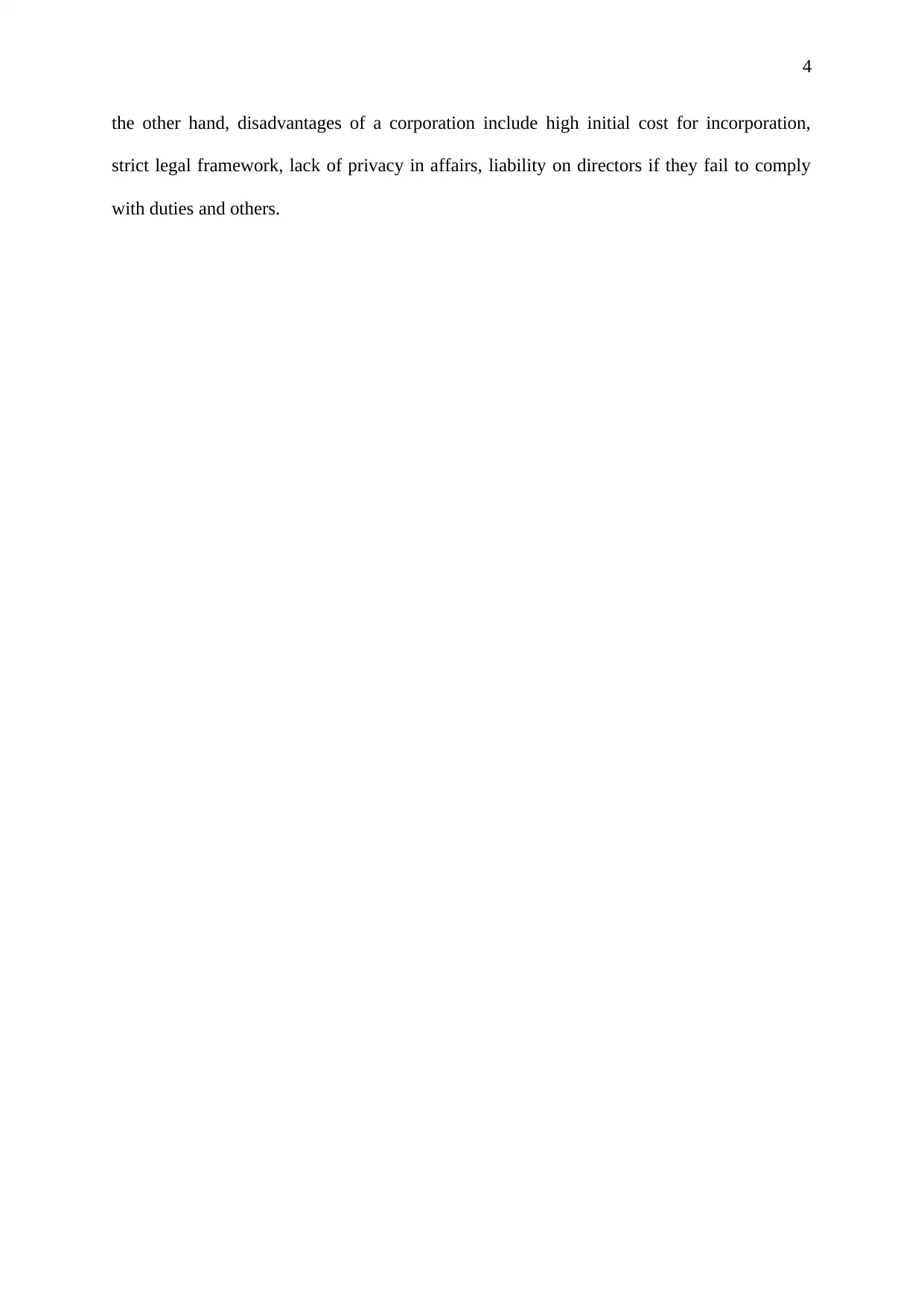
4
the other hand, disadvantages of a corporation include high initial cost for incorporation,
strict legal framework, lack of privacy in affairs, liability on directors if they fail to comply
with duties and others.
the other hand, disadvantages of a corporation include high initial cost for incorporation,
strict legal framework, lack of privacy in affairs, liability on directors if they fail to comply
with duties and others.
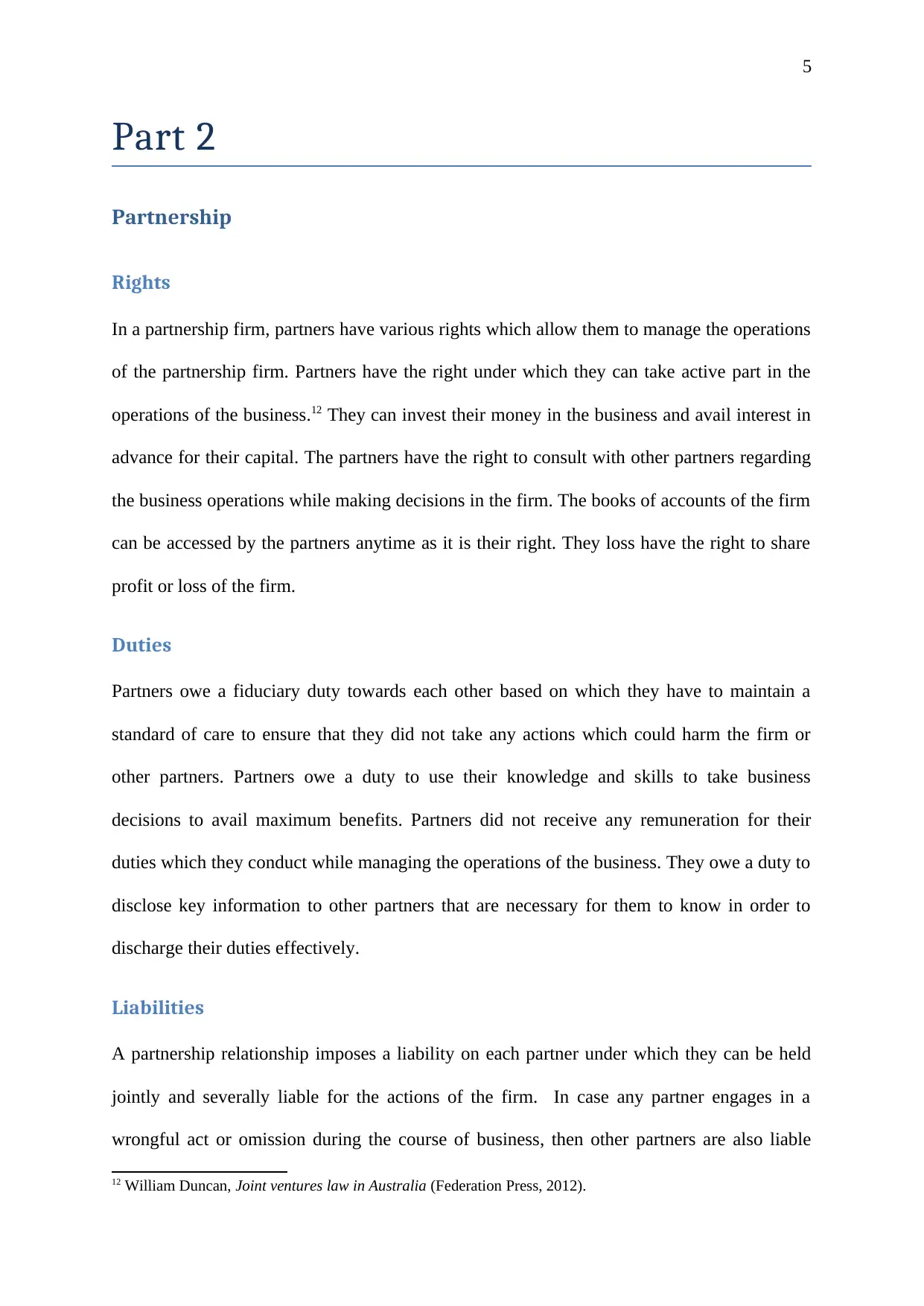
5
Part 2
Partnership
Rights
In a partnership firm, partners have various rights which allow them to manage the operations
of the partnership firm. Partners have the right under which they can take active part in the
operations of the business.12 They can invest their money in the business and avail interest in
advance for their capital. The partners have the right to consult with other partners regarding
the business operations while making decisions in the firm. The books of accounts of the firm
can be accessed by the partners anytime as it is their right. They loss have the right to share
profit or loss of the firm.
Duties
Partners owe a fiduciary duty towards each other based on which they have to maintain a
standard of care to ensure that they did not take any actions which could harm the firm or
other partners. Partners owe a duty to use their knowledge and skills to take business
decisions to avail maximum benefits. Partners did not receive any remuneration for their
duties which they conduct while managing the operations of the business. They owe a duty to
disclose key information to other partners that are necessary for them to know in order to
discharge their duties effectively.
Liabilities
A partnership relationship imposes a liability on each partner under which they can be held
jointly and severally liable for the actions of the firm. In case any partner engages in a
wrongful act or omission during the course of business, then other partners are also liable
12 William Duncan, Joint ventures law in Australia (Federation Press, 2012).
Part 2
Partnership
Rights
In a partnership firm, partners have various rights which allow them to manage the operations
of the partnership firm. Partners have the right under which they can take active part in the
operations of the business.12 They can invest their money in the business and avail interest in
advance for their capital. The partners have the right to consult with other partners regarding
the business operations while making decisions in the firm. The books of accounts of the firm
can be accessed by the partners anytime as it is their right. They loss have the right to share
profit or loss of the firm.
Duties
Partners owe a fiduciary duty towards each other based on which they have to maintain a
standard of care to ensure that they did not take any actions which could harm the firm or
other partners. Partners owe a duty to use their knowledge and skills to take business
decisions to avail maximum benefits. Partners did not receive any remuneration for their
duties which they conduct while managing the operations of the business. They owe a duty to
disclose key information to other partners that are necessary for them to know in order to
discharge their duties effectively.
Liabilities
A partnership relationship imposes a liability on each partner under which they can be held
jointly and severally liable for the actions of the firm. In case any partner engages in a
wrongful act or omission during the course of business, then other partners are also liable
12 William Duncan, Joint ventures law in Australia (Federation Press, 2012).
⊘ This is a preview!⊘
Do you want full access?
Subscribe today to unlock all pages.

Trusted by 1+ million students worldwide
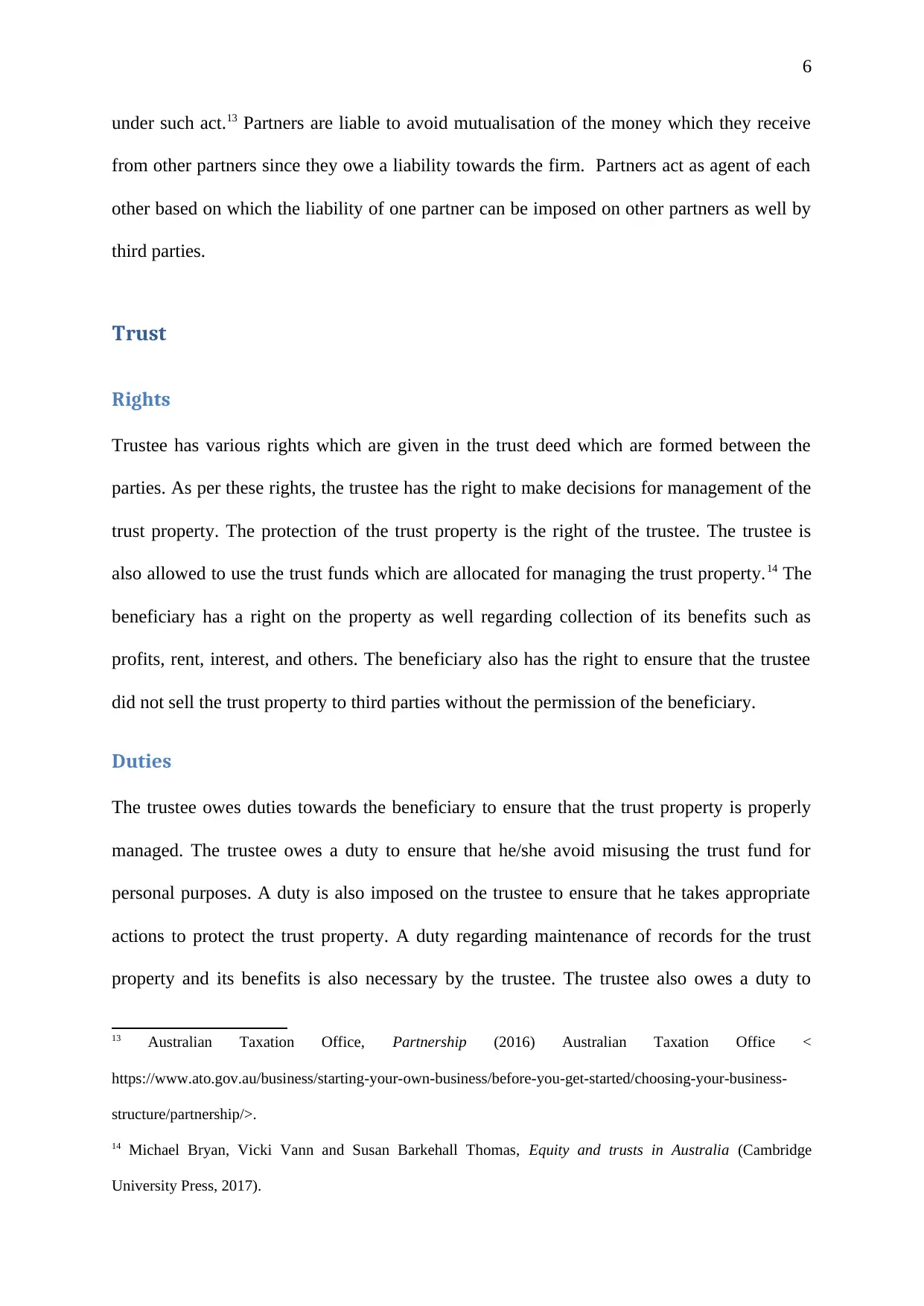
6
under such act.13 Partners are liable to avoid mutualisation of the money which they receive
from other partners since they owe a liability towards the firm. Partners act as agent of each
other based on which the liability of one partner can be imposed on other partners as well by
third parties.
Trust
Rights
Trustee has various rights which are given in the trust deed which are formed between the
parties. As per these rights, the trustee has the right to make decisions for management of the
trust property. The protection of the trust property is the right of the trustee. The trustee is
also allowed to use the trust funds which are allocated for managing the trust property.14 The
beneficiary has a right on the property as well regarding collection of its benefits such as
profits, rent, interest, and others. The beneficiary also has the right to ensure that the trustee
did not sell the trust property to third parties without the permission of the beneficiary.
Duties
The trustee owes duties towards the beneficiary to ensure that the trust property is properly
managed. The trustee owes a duty to ensure that he/she avoid misusing the trust fund for
personal purposes. A duty is also imposed on the trustee to ensure that he takes appropriate
actions to protect the trust property. A duty regarding maintenance of records for the trust
property and its benefits is also necessary by the trustee. The trustee also owes a duty to
13 Australian Taxation Office, Partnership (2016) Australian Taxation Office <
https://www.ato.gov.au/business/starting-your-own-business/before-you-get-started/choosing-your-business-
structure/partnership/>.
14 Michael Bryan, Vicki Vann and Susan Barkehall Thomas, Equity and trusts in Australia (Cambridge
University Press, 2017).
under such act.13 Partners are liable to avoid mutualisation of the money which they receive
from other partners since they owe a liability towards the firm. Partners act as agent of each
other based on which the liability of one partner can be imposed on other partners as well by
third parties.
Trust
Rights
Trustee has various rights which are given in the trust deed which are formed between the
parties. As per these rights, the trustee has the right to make decisions for management of the
trust property. The protection of the trust property is the right of the trustee. The trustee is
also allowed to use the trust funds which are allocated for managing the trust property.14 The
beneficiary has a right on the property as well regarding collection of its benefits such as
profits, rent, interest, and others. The beneficiary also has the right to ensure that the trustee
did not sell the trust property to third parties without the permission of the beneficiary.
Duties
The trustee owes duties towards the beneficiary to ensure that the trust property is properly
managed. The trustee owes a duty to ensure that he/she avoid misusing the trust fund for
personal purposes. A duty is also imposed on the trustee to ensure that he takes appropriate
actions to protect the trust property. A duty regarding maintenance of records for the trust
property and its benefits is also necessary by the trustee. The trustee also owes a duty to
13 Australian Taxation Office, Partnership (2016) Australian Taxation Office <
https://www.ato.gov.au/business/starting-your-own-business/before-you-get-started/choosing-your-business-
structure/partnership/>.
14 Michael Bryan, Vicki Vann and Susan Barkehall Thomas, Equity and trusts in Australia (Cambridge
University Press, 2017).
Paraphrase This Document
Need a fresh take? Get an instant paraphrase of this document with our AI Paraphraser
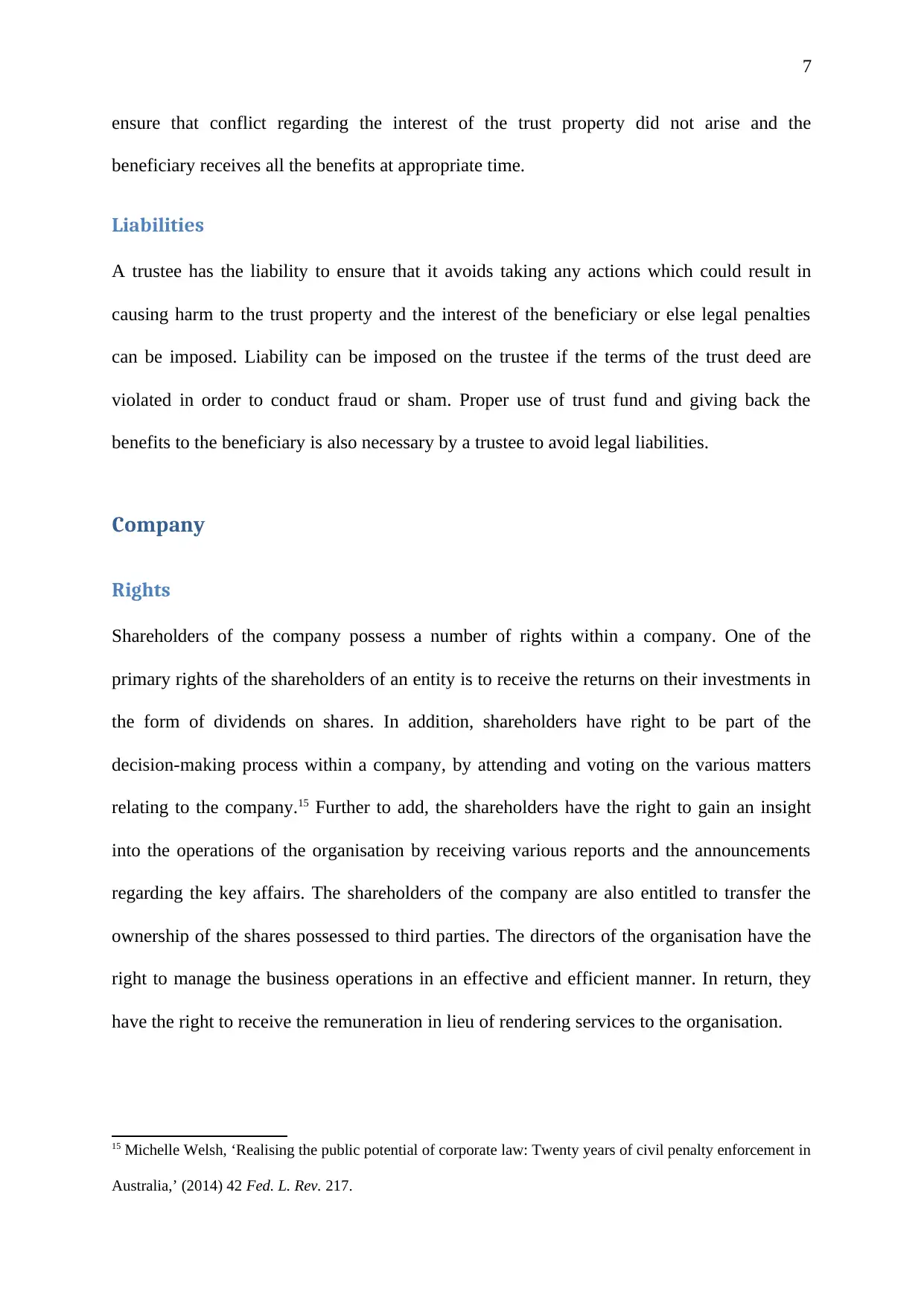
7
ensure that conflict regarding the interest of the trust property did not arise and the
beneficiary receives all the benefits at appropriate time.
Liabilities
A trustee has the liability to ensure that it avoids taking any actions which could result in
causing harm to the trust property and the interest of the beneficiary or else legal penalties
can be imposed. Liability can be imposed on the trustee if the terms of the trust deed are
violated in order to conduct fraud or sham. Proper use of trust fund and giving back the
benefits to the beneficiary is also necessary by a trustee to avoid legal liabilities.
Company
Rights
Shareholders of the company possess a number of rights within a company. One of the
primary rights of the shareholders of an entity is to receive the returns on their investments in
the form of dividends on shares. In addition, shareholders have right to be part of the
decision-making process within a company, by attending and voting on the various matters
relating to the company.15 Further to add, the shareholders have the right to gain an insight
into the operations of the organisation by receiving various reports and the announcements
regarding the key affairs. The shareholders of the company are also entitled to transfer the
ownership of the shares possessed to third parties. The directors of the organisation have the
right to manage the business operations in an effective and efficient manner. In return, they
have the right to receive the remuneration in lieu of rendering services to the organisation.
15 Michelle Welsh, ‘Realising the public potential of corporate law: Twenty years of civil penalty enforcement in
Australia,’ (2014) 42 Fed. L. Rev. 217.
ensure that conflict regarding the interest of the trust property did not arise and the
beneficiary receives all the benefits at appropriate time.
Liabilities
A trustee has the liability to ensure that it avoids taking any actions which could result in
causing harm to the trust property and the interest of the beneficiary or else legal penalties
can be imposed. Liability can be imposed on the trustee if the terms of the trust deed are
violated in order to conduct fraud or sham. Proper use of trust fund and giving back the
benefits to the beneficiary is also necessary by a trustee to avoid legal liabilities.
Company
Rights
Shareholders of the company possess a number of rights within a company. One of the
primary rights of the shareholders of an entity is to receive the returns on their investments in
the form of dividends on shares. In addition, shareholders have right to be part of the
decision-making process within a company, by attending and voting on the various matters
relating to the company.15 Further to add, the shareholders have the right to gain an insight
into the operations of the organisation by receiving various reports and the announcements
regarding the key affairs. The shareholders of the company are also entitled to transfer the
ownership of the shares possessed to third parties. The directors of the organisation have the
right to manage the business operations in an effective and efficient manner. In return, they
have the right to receive the remuneration in lieu of rendering services to the organisation.
15 Michelle Welsh, ‘Realising the public potential of corporate law: Twenty years of civil penalty enforcement in
Australia,’ (2014) 42 Fed. L. Rev. 217.
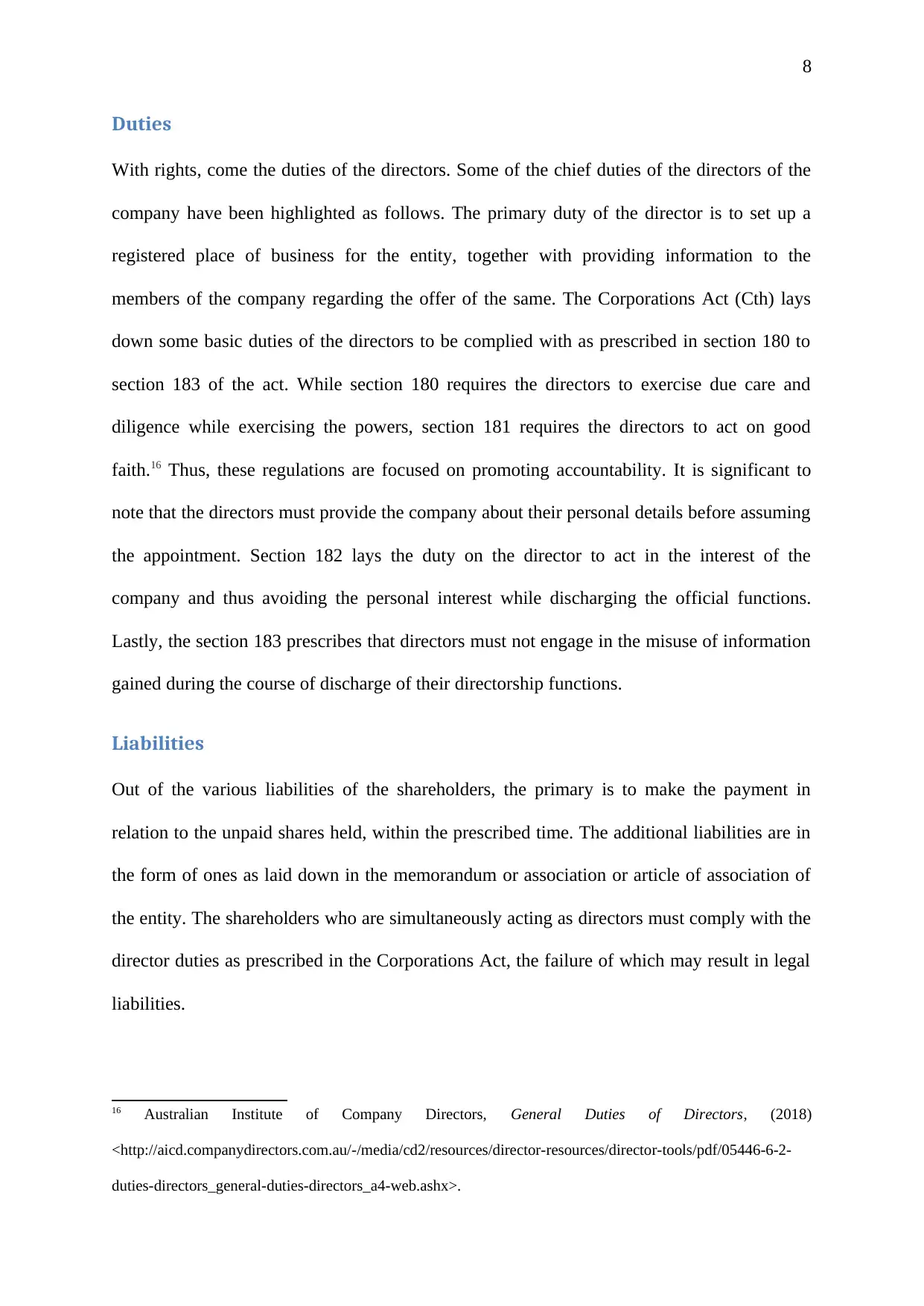
8
Duties
With rights, come the duties of the directors. Some of the chief duties of the directors of the
company have been highlighted as follows. The primary duty of the director is to set up a
registered place of business for the entity, together with providing information to the
members of the company regarding the offer of the same. The Corporations Act (Cth) lays
down some basic duties of the directors to be complied with as prescribed in section 180 to
section 183 of the act. While section 180 requires the directors to exercise due care and
diligence while exercising the powers, section 181 requires the directors to act on good
faith.16 Thus, these regulations are focused on promoting accountability. It is significant to
note that the directors must provide the company about their personal details before assuming
the appointment. Section 182 lays the duty on the director to act in the interest of the
company and thus avoiding the personal interest while discharging the official functions.
Lastly, the section 183 prescribes that directors must not engage in the misuse of information
gained during the course of discharge of their directorship functions.
Liabilities
Out of the various liabilities of the shareholders, the primary is to make the payment in
relation to the unpaid shares held, within the prescribed time. The additional liabilities are in
the form of ones as laid down in the memorandum or association or article of association of
the entity. The shareholders who are simultaneously acting as directors must comply with the
director duties as prescribed in the Corporations Act, the failure of which may result in legal
liabilities.
16 Australian Institute of Company Directors, General Duties of Directors, (2018)
<http://aicd.companydirectors.com.au/-/media/cd2/resources/director-resources/director-tools/pdf/05446-6-2-
duties-directors_general-duties-directors_a4-web.ashx>.
Duties
With rights, come the duties of the directors. Some of the chief duties of the directors of the
company have been highlighted as follows. The primary duty of the director is to set up a
registered place of business for the entity, together with providing information to the
members of the company regarding the offer of the same. The Corporations Act (Cth) lays
down some basic duties of the directors to be complied with as prescribed in section 180 to
section 183 of the act. While section 180 requires the directors to exercise due care and
diligence while exercising the powers, section 181 requires the directors to act on good
faith.16 Thus, these regulations are focused on promoting accountability. It is significant to
note that the directors must provide the company about their personal details before assuming
the appointment. Section 182 lays the duty on the director to act in the interest of the
company and thus avoiding the personal interest while discharging the official functions.
Lastly, the section 183 prescribes that directors must not engage in the misuse of information
gained during the course of discharge of their directorship functions.
Liabilities
Out of the various liabilities of the shareholders, the primary is to make the payment in
relation to the unpaid shares held, within the prescribed time. The additional liabilities are in
the form of ones as laid down in the memorandum or association or article of association of
the entity. The shareholders who are simultaneously acting as directors must comply with the
director duties as prescribed in the Corporations Act, the failure of which may result in legal
liabilities.
16 Australian Institute of Company Directors, General Duties of Directors, (2018)
<http://aicd.companydirectors.com.au/-/media/cd2/resources/director-resources/director-tools/pdf/05446-6-2-
duties-directors_general-duties-directors_a4-web.ashx>.
⊘ This is a preview!⊘
Do you want full access?
Subscribe today to unlock all pages.

Trusted by 1+ million students worldwide
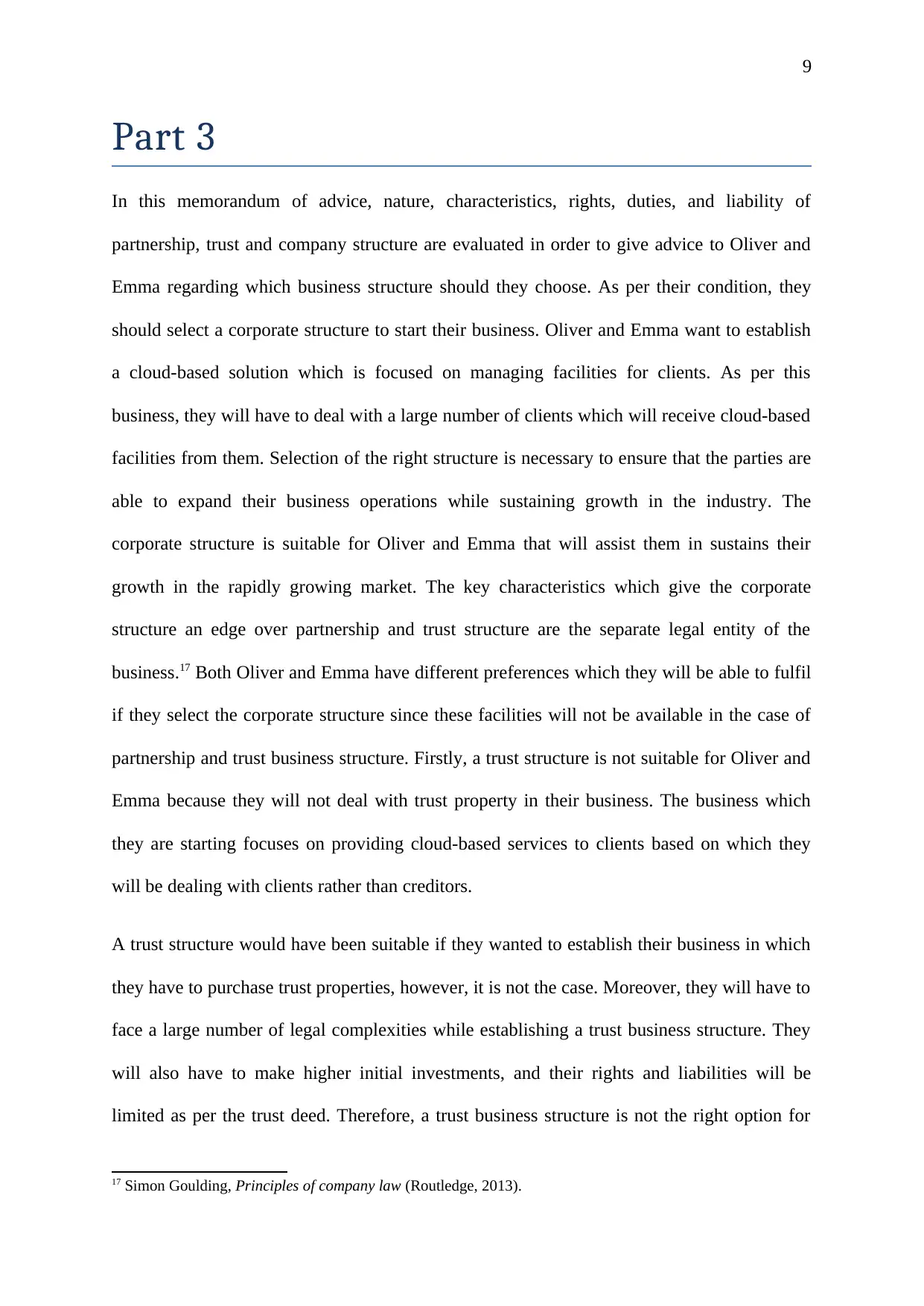
9
Part 3
In this memorandum of advice, nature, characteristics, rights, duties, and liability of
partnership, trust and company structure are evaluated in order to give advice to Oliver and
Emma regarding which business structure should they choose. As per their condition, they
should select a corporate structure to start their business. Oliver and Emma want to establish
a cloud-based solution which is focused on managing facilities for clients. As per this
business, they will have to deal with a large number of clients which will receive cloud-based
facilities from them. Selection of the right structure is necessary to ensure that the parties are
able to expand their business operations while sustaining growth in the industry. The
corporate structure is suitable for Oliver and Emma that will assist them in sustains their
growth in the rapidly growing market. The key characteristics which give the corporate
structure an edge over partnership and trust structure are the separate legal entity of the
business.17 Both Oliver and Emma have different preferences which they will be able to fulfil
if they select the corporate structure since these facilities will not be available in the case of
partnership and trust business structure. Firstly, a trust structure is not suitable for Oliver and
Emma because they will not deal with trust property in their business. The business which
they are starting focuses on providing cloud-based services to clients based on which they
will be dealing with clients rather than creditors.
A trust structure would have been suitable if they wanted to establish their business in which
they have to purchase trust properties, however, it is not the case. Moreover, they will have to
face a large number of legal complexities while establishing a trust business structure. They
will also have to make higher initial investments, and their rights and liabilities will be
limited as per the trust deed. Therefore, a trust business structure is not the right option for
17 Simon Goulding, Principles of company law (Routledge, 2013).
Part 3
In this memorandum of advice, nature, characteristics, rights, duties, and liability of
partnership, trust and company structure are evaluated in order to give advice to Oliver and
Emma regarding which business structure should they choose. As per their condition, they
should select a corporate structure to start their business. Oliver and Emma want to establish
a cloud-based solution which is focused on managing facilities for clients. As per this
business, they will have to deal with a large number of clients which will receive cloud-based
facilities from them. Selection of the right structure is necessary to ensure that the parties are
able to expand their business operations while sustaining growth in the industry. The
corporate structure is suitable for Oliver and Emma that will assist them in sustains their
growth in the rapidly growing market. The key characteristics which give the corporate
structure an edge over partnership and trust structure are the separate legal entity of the
business.17 Both Oliver and Emma have different preferences which they will be able to fulfil
if they select the corporate structure since these facilities will not be available in the case of
partnership and trust business structure. Firstly, a trust structure is not suitable for Oliver and
Emma because they will not deal with trust property in their business. The business which
they are starting focuses on providing cloud-based services to clients based on which they
will be dealing with clients rather than creditors.
A trust structure would have been suitable if they wanted to establish their business in which
they have to purchase trust properties, however, it is not the case. Moreover, they will have to
face a large number of legal complexities while establishing a trust business structure. They
will also have to make higher initial investments, and their rights and liabilities will be
limited as per the trust deed. Therefore, a trust business structure is not the right option for
17 Simon Goulding, Principles of company law (Routledge, 2013).
Paraphrase This Document
Need a fresh take? Get an instant paraphrase of this document with our AI Paraphraser
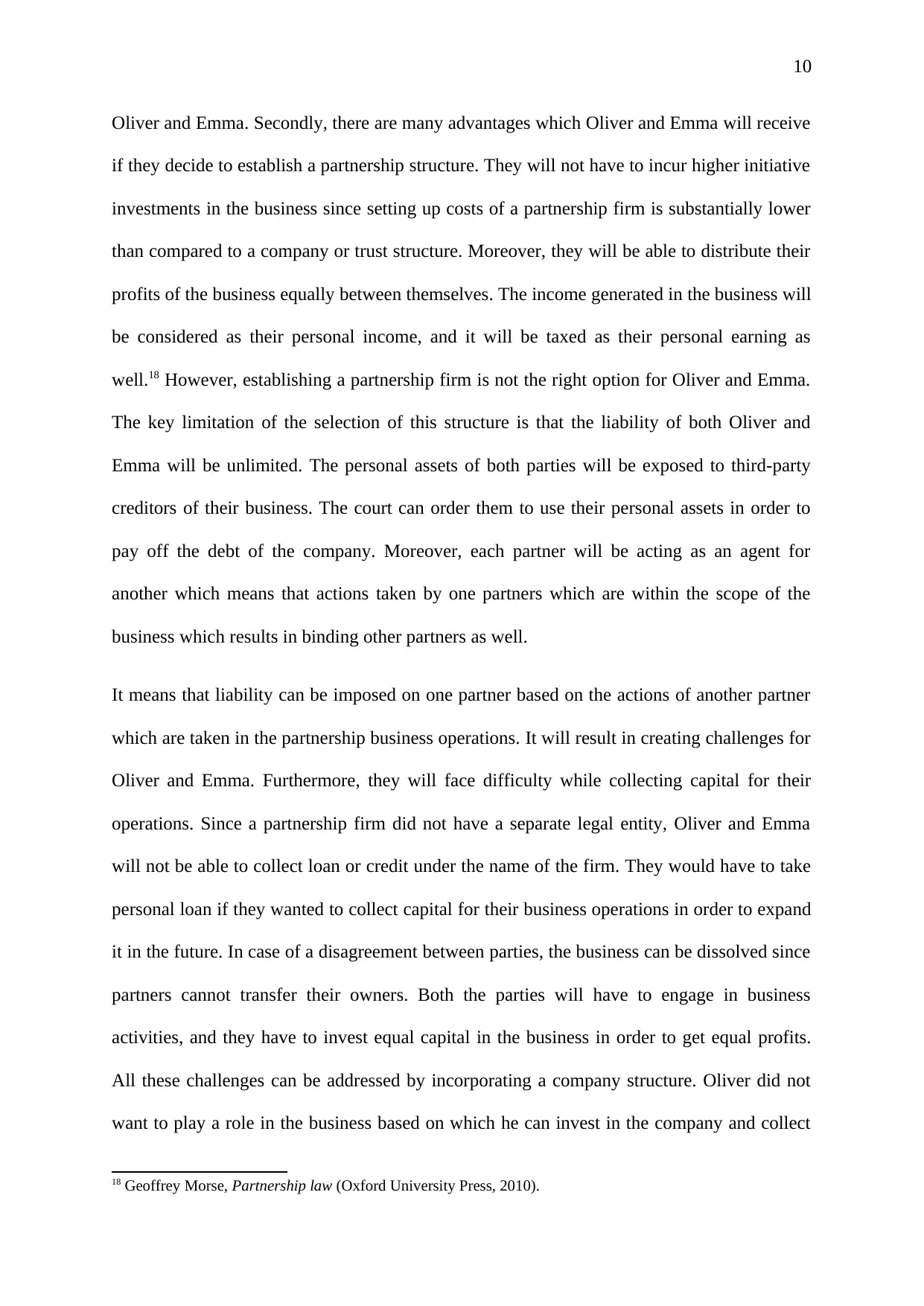
10
Oliver and Emma. Secondly, there are many advantages which Oliver and Emma will receive
if they decide to establish a partnership structure. They will not have to incur higher initiative
investments in the business since setting up costs of a partnership firm is substantially lower
than compared to a company or trust structure. Moreover, they will be able to distribute their
profits of the business equally between themselves. The income generated in the business will
be considered as their personal income, and it will be taxed as their personal earning as
well.18 However, establishing a partnership firm is not the right option for Oliver and Emma.
The key limitation of the selection of this structure is that the liability of both Oliver and
Emma will be unlimited. The personal assets of both parties will be exposed to third-party
creditors of their business. The court can order them to use their personal assets in order to
pay off the debt of the company. Moreover, each partner will be acting as an agent for
another which means that actions taken by one partners which are within the scope of the
business which results in binding other partners as well.
It means that liability can be imposed on one partner based on the actions of another partner
which are taken in the partnership business operations. It will result in creating challenges for
Oliver and Emma. Furthermore, they will face difficulty while collecting capital for their
operations. Since a partnership firm did not have a separate legal entity, Oliver and Emma
will not be able to collect loan or credit under the name of the firm. They would have to take
personal loan if they wanted to collect capital for their business operations in order to expand
it in the future. In case of a disagreement between parties, the business can be dissolved since
partners cannot transfer their owners. Both the parties will have to engage in business
activities, and they have to invest equal capital in the business in order to get equal profits.
All these challenges can be addressed by incorporating a company structure. Oliver did not
want to play a role in the business based on which he can invest in the company and collect
18 Geoffrey Morse, Partnership law (Oxford University Press, 2010).
Oliver and Emma. Secondly, there are many advantages which Oliver and Emma will receive
if they decide to establish a partnership structure. They will not have to incur higher initiative
investments in the business since setting up costs of a partnership firm is substantially lower
than compared to a company or trust structure. Moreover, they will be able to distribute their
profits of the business equally between themselves. The income generated in the business will
be considered as their personal income, and it will be taxed as their personal earning as
well.18 However, establishing a partnership firm is not the right option for Oliver and Emma.
The key limitation of the selection of this structure is that the liability of both Oliver and
Emma will be unlimited. The personal assets of both parties will be exposed to third-party
creditors of their business. The court can order them to use their personal assets in order to
pay off the debt of the company. Moreover, each partner will be acting as an agent for
another which means that actions taken by one partners which are within the scope of the
business which results in binding other partners as well.
It means that liability can be imposed on one partner based on the actions of another partner
which are taken in the partnership business operations. It will result in creating challenges for
Oliver and Emma. Furthermore, they will face difficulty while collecting capital for their
operations. Since a partnership firm did not have a separate legal entity, Oliver and Emma
will not be able to collect loan or credit under the name of the firm. They would have to take
personal loan if they wanted to collect capital for their business operations in order to expand
it in the future. In case of a disagreement between parties, the business can be dissolved since
partners cannot transfer their owners. Both the parties will have to engage in business
activities, and they have to invest equal capital in the business in order to get equal profits.
All these challenges can be addressed by incorporating a company structure. Oliver did not
want to play a role in the business based on which he can invest in the company and collect
18 Geoffrey Morse, Partnership law (Oxford University Press, 2010).
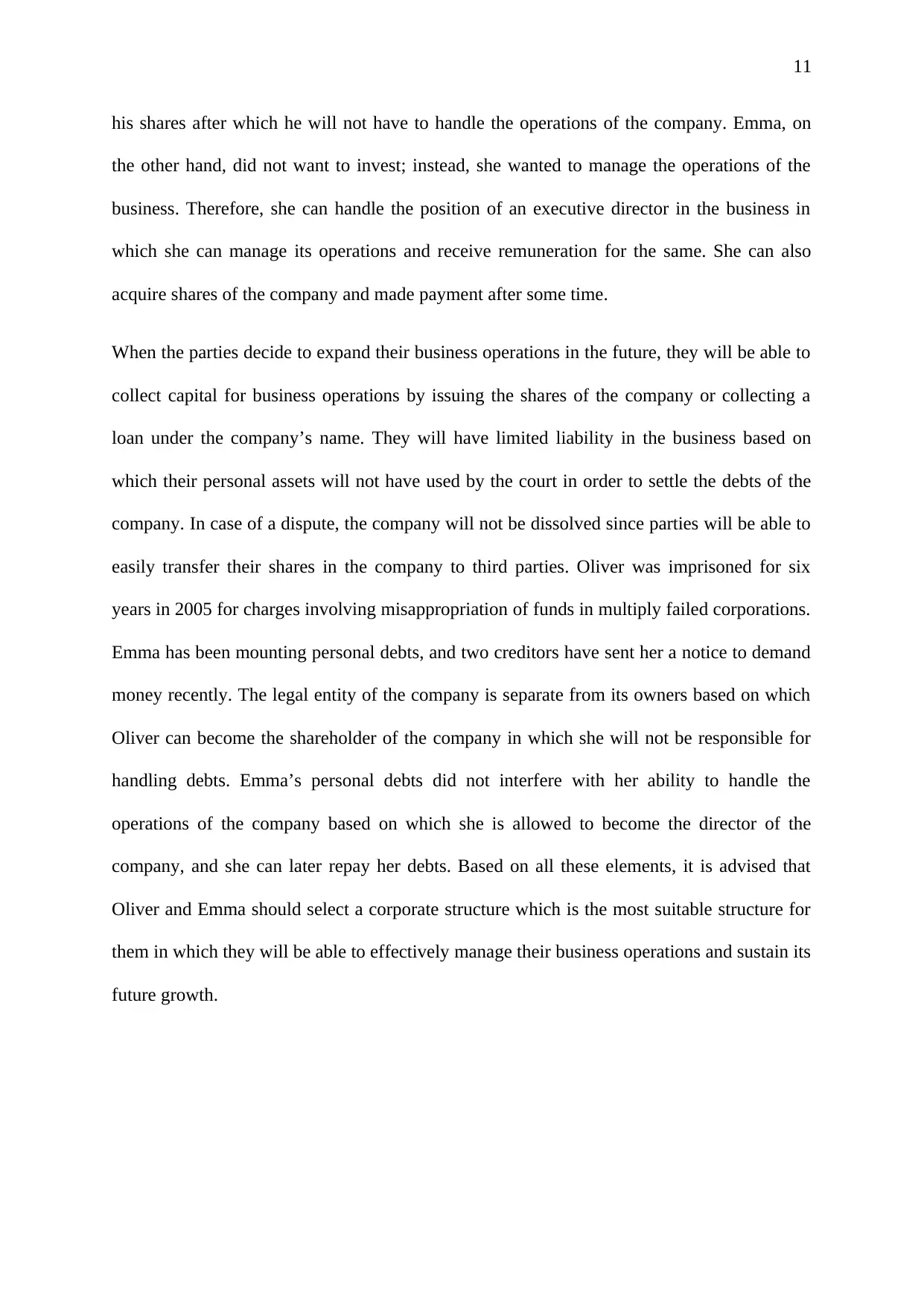
11
his shares after which he will not have to handle the operations of the company. Emma, on
the other hand, did not want to invest; instead, she wanted to manage the operations of the
business. Therefore, she can handle the position of an executive director in the business in
which she can manage its operations and receive remuneration for the same. She can also
acquire shares of the company and made payment after some time.
When the parties decide to expand their business operations in the future, they will be able to
collect capital for business operations by issuing the shares of the company or collecting a
loan under the company’s name. They will have limited liability in the business based on
which their personal assets will not have used by the court in order to settle the debts of the
company. In case of a dispute, the company will not be dissolved since parties will be able to
easily transfer their shares in the company to third parties. Oliver was imprisoned for six
years in 2005 for charges involving misappropriation of funds in multiply failed corporations.
Emma has been mounting personal debts, and two creditors have sent her a notice to demand
money recently. The legal entity of the company is separate from its owners based on which
Oliver can become the shareholder of the company in which she will not be responsible for
handling debts. Emma’s personal debts did not interfere with her ability to handle the
operations of the company based on which she is allowed to become the director of the
company, and she can later repay her debts. Based on all these elements, it is advised that
Oliver and Emma should select a corporate structure which is the most suitable structure for
them in which they will be able to effectively manage their business operations and sustain its
future growth.
his shares after which he will not have to handle the operations of the company. Emma, on
the other hand, did not want to invest; instead, she wanted to manage the operations of the
business. Therefore, she can handle the position of an executive director in the business in
which she can manage its operations and receive remuneration for the same. She can also
acquire shares of the company and made payment after some time.
When the parties decide to expand their business operations in the future, they will be able to
collect capital for business operations by issuing the shares of the company or collecting a
loan under the company’s name. They will have limited liability in the business based on
which their personal assets will not have used by the court in order to settle the debts of the
company. In case of a dispute, the company will not be dissolved since parties will be able to
easily transfer their shares in the company to third parties. Oliver was imprisoned for six
years in 2005 for charges involving misappropriation of funds in multiply failed corporations.
Emma has been mounting personal debts, and two creditors have sent her a notice to demand
money recently. The legal entity of the company is separate from its owners based on which
Oliver can become the shareholder of the company in which she will not be responsible for
handling debts. Emma’s personal debts did not interfere with her ability to handle the
operations of the company based on which she is allowed to become the director of the
company, and she can later repay her debts. Based on all these elements, it is advised that
Oliver and Emma should select a corporate structure which is the most suitable structure for
them in which they will be able to effectively manage their business operations and sustain its
future growth.
⊘ This is a preview!⊘
Do you want full access?
Subscribe today to unlock all pages.

Trusted by 1+ million students worldwide
1 out of 14
Related Documents
Your All-in-One AI-Powered Toolkit for Academic Success.
+13062052269
info@desklib.com
Available 24*7 on WhatsApp / Email
![[object Object]](/_next/static/media/star-bottom.7253800d.svg)
Unlock your academic potential
Copyright © 2020–2025 A2Z Services. All Rights Reserved. Developed and managed by ZUCOL.



